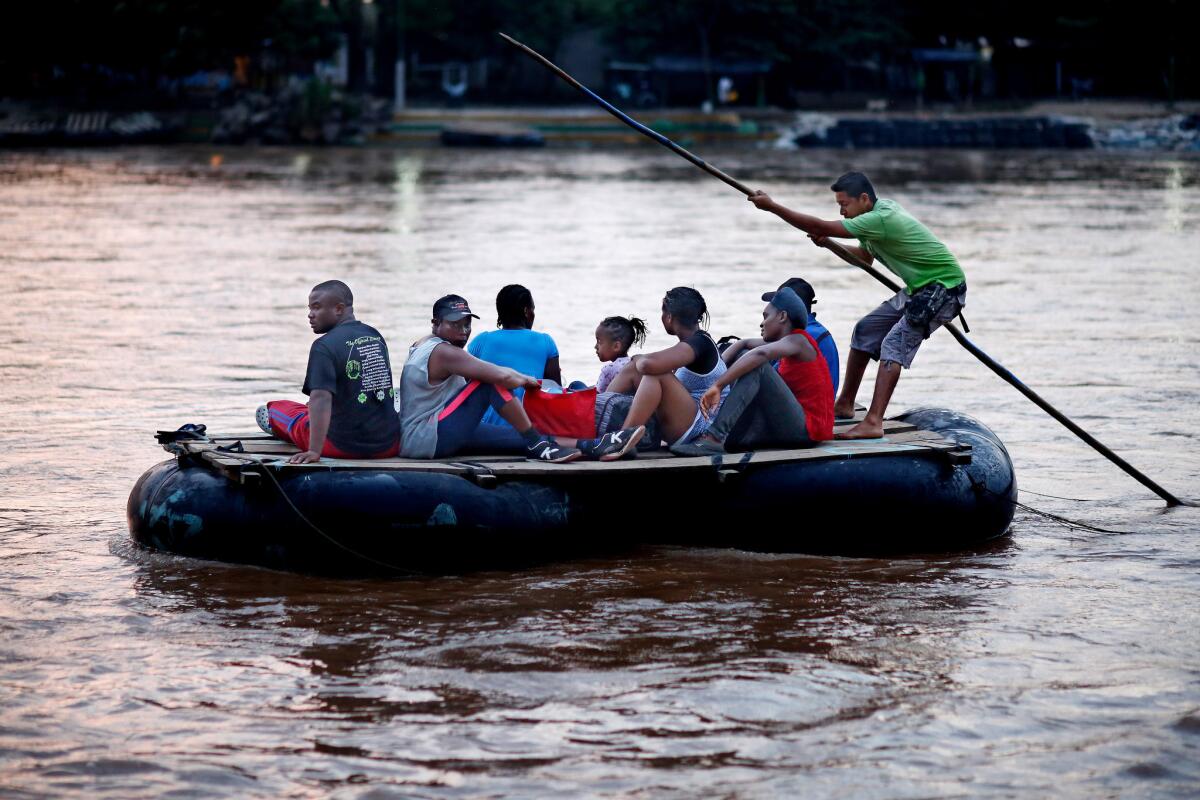Traversing the Rio Suchiate: Between Africa and the U.S., an illicit river crossing in Latin America

- Share via
Reporting from CIUDAD HIDALGO, Mexico — From across the Rio Suchiate comes a staccato patois, not Spanish, not quite French. Distant figures on the Guatemalan bank of the river begin to board a flotilla of wooden rafts, moored beneath a white cross tinting pink as dawn approaches.
Soon, the wobbly fleet plunges into the murky water, the passengers perched unsteadily on planks lashed to inner tubes. The drivers dip long poles into the river bed for propulsion.
“Africanos!” murmurs one of the bicycle rickshaw drivers on the Mexican side, waiting for the fresh arrivals from Guatemala to reach shore.
The 60 or travelers — all black, mostly young men, but also several women and children — disembark and gather up their backpacks and bags. Three Somali women don the distinctive headdresses of their East African homeland. All make their way hastily up the slippery incline, passing trash heaps, scurrying rats and campfires warming coffee and tortillas.
“We are from Congo,” explains Luc Hillegeon, 31, as he, his wife and infant son navigate the muddy path beneath the majestic ceiba trees. “We would like to go to the USA.”
::
The Rio Suchiate has long been one of the world’s great migratory way stations, an illicit crossing point for generations of Central Americans seeking to enter Mexico on their way to the United States. Multitudes of Salvadorans, Hondurans, Guatemalans and others now settled in cities from Los Angeles to Washington, D.C., initially crossed into Mexico aboard those same inner tube rafts, fording the river that separates Mexico from the isthmus of Central America.
The illegal flow of Central Americans has long been a concern for U.S. immigration authorities. A team of U.S. immigration officials is based in the Mexican city of Tapachula, a migrant hub 30 miles north of the river, helping Mexico beef up its southern border.
But arrivals on that recent day weren’t Central Americans. The group of 50 or so were part of a striking increase in what Mexican officials refer to as extra-continentales, or non-Latin Americans, crossing into Mexico, all destined for the United States.
An average of more than 1,500 such migrants a month — from Asia, Africa and Haiti—have been arriving in Mexico’s southern Chiapas state, across the Rio Suchiate from Guatemala. Mexican officials say they have never before seen such a surge of non-Latin Americans here.
Most of the “extra-continentals” turn themselves in voluntarily to Mexican authorities, forming orderly queues each morning outside the federal immigration detention center in Tapachula.
Mexico has adopted what officials call a “humanitarian” policy, granting most of the new arrivals a 20-day window to leave the country — enough time, in theory, to make it the United States.
::
Tapachula, a bustling, sweltering city in the shadow of the Tacaná volcano, has all the usual amenities of a border town — flop houses, cellphone shops, mini-markets and scores of bars and travel agencies.
Ibrahim Anyars, 32, a tall, slender native of Ghana, was sitting one recent afternoon at an outdoor table in a restaurant catering to the travelers.
A tailor from the Ashanti region of Ghana, Anyars seemed disoriented. Like many other Africans, Anyars’ American sojourn had begun in Ecuador, where he had arrived by plane in January. He found work as a tailor and remained in Ecuador for almost six months, saving money for his trip north.
In July, Anyars, his older brother and a group of other Ghanians set out for Colombia and the trip north to Panama, navigating the infamous stretch of rainforest known as the Darién Gap, an impenetrable and unforgiving wilderness zone.
In July, while crossing a river, his brother, Rafik Ibrahim, 36, fell into the water.
Mohammed Sani Idris, another young Ghanian traveling with Anyars that day, said that as the group combed the river in search of their missing comrade, a tropical rainstorm turned the water into a raging torrent, threatening to sweep everyone away. They finally had to abandon the search.
Later, when cellphones regained signals, it was left to Anyars to call his family with the catastrophic news. Fighting back tears as he recalled that conversation, he said he told them: “There was nothing we could do.”
His brother’s body washed up on shore several days later, found by some Senegalese migrants whom the Ghanians had met on the boat trip from Colombia to Panama.
Anyars, Idris and his older brother, Muthana, wound up at a Catholic shelter outside Tapachula officially called the House of Jesus the Good Pastor, but widely known as the Casa de Los Mutilados, or House of the Mutilated. The facility long served as a rehabilitation center for Central Americans who lost limbs after hitching rides to the north on the infamous freight train known as La Bestia.
In the courtyard of the shelter was a pair of paintings showing smiling amputees.
All three Ghanians already had 20-day passes from the Mexican government and were planning to head to the U.S.-Mexico border in a day or two, as soon as they came up with the bus fare — about $72 each — to Tijuana. Idris and his brother said they hoped to reach Canada, though they knew no one there.
The brothers said they had no alternative but to keep pressing on. They are homosexuals, and in Ghana, they said, life had become too dangerous to stay.
“My whole community was trying to kill me,” said Muthana Idris, a muscular 22-year-old.
::
Many of the migrants from Africa and Haiti find their way to “Mama Africa’s,” a budget hotel formally known as The Imperial. Its manager is Concepcion Gonzalez Ramirez, whom every one calls Mama Africa.
Residents pay about $2.50 a night, often for a mattress in the lobby, which is inevitably filled with migrants chatting with relatives and friends back home on their cellphones or watching films. WiFi is free.
“Before, I really didn’t know much about African people,” said Gonzalez, 57, a petite Mexican woman in glasses who fusses over every detail in the hotel. “But now I feel blessed to have known them,” she said.
The feeling is reciprocal.
“We all love Mama Africa,” said Herold Nossirel, 27, who appears to be Haitian, but says he is from Congo — a ruse that many Haitians use to avoid deportation. He speaks Spanish with a Portuguese accent, evidence of the two years he spent in Brazil, where many Haitians worked before the economy took a steep downturn.
As he spoke, a group of four more migrants who appeared to be from Haiti arrived at the front door. They had missed their bus to the northern border and needed a place to stay. At first, Gonzalez looked at them with suspicion. The day before, one in the group had left without paying his bill. She chided him. He apologized profusely. She let them find a place on the floor.
“What can I do?” said Gonzalez. “We are all human beings.”
::
The sign outside reads Comida Economica, cheap food, but the eatery is better known as the “Bangladeshi Restaurant.” Its manager, Mohammed Sadek Hussein, 27, left his homeland two years ago because of what he calls “political problems.”
He arrived in South America, intending to join the migration north to the United States, but made it only as far as Tapachula, where he abandoned his dream.
Instead, Sadek became an entrepreneur in this polyglot way station, providing a crucial service to a burgeoning migrant population who, after all, must eat. For $2, Sadek offers a square meal of meat, rice and vegetables.
At dinner time, a lively, multi-lingual clientele fills the house, exchanging gossip in sundry tongues and watching movies on their cellphones in Punjabi, Hindi, French and English.
Taking a break from watching a Bollywood flick on his smartphone, Sadek surveyed the crowd. “I don’t mind Mexico,” he said.
One of the patrons, Kamran Akram, 34, from Pakistan’s Punjab region, described the journey that had brought him here. It began when he had fled Pakistan after a dispute with his employer, taking a flight to Sao Paulo two years ago.
But life in Brazil was difficult — he had to beg friends for food. In early April, he decided to head for the United States, taking a network of buses to Colombia, crossing the Darién on foot and making his way across the five Central American nations migrants must cross to reach Mexico. His family had sold their house in Punjab to finance his travel, but in Nicaragua, he was robbed of his cash.
“Can you imagine the shame?” he said, puffing on a cigarette.
Unable to go home and unable to stay in Mexico, he planned to head for the U.S.-Mexican border, joining the multitudes of would-be Americans.
::
At the Palafox Hotel across the street, where rooms start at $12 dollars a night, the patio is festooned with drying laundry. Some rooms are labeled with the homelands of the residents.
A sign on the door of Aisha Abdul-Lahi’s room read: “Somalia.”
Abdul-Lahi’s journey was even longer than most. She fled Mogadishu, after an arranged marriage at the age of 14 to an abusive man more than 30 years her senior, and made it to South Africa, where she worked as a domestic for two years to save money.
In June, she flew to Brazil and embarked on an overland excursion that took her to the Colombian coast, where she caught a boat to the Panamanian border.
She traveled with fellow Somalians and others who helped her along the way. Now, she was planning to leave the next day for the U.S.-Mexico border. A friend had lent her the $200 for the plane trip to Tijuana, a relative luxury, since most people take the more economical bus route, a three-day excursion. She seemed elated.
“I hope to start a new life in the United States, a peaceful, normal life, and bring my family,” said Abdul-Lahi, 25, whose two sons, ages 6 and 8, were still in Somalia. “Once I am there, this will all have been worth it.”
Cecilia Sanchez of The Times’ Mexico City bureau contributed.
twitter: @mcdneville
More to Read
Sign up for Essential California
The most important California stories and recommendations in your inbox every morning.
You may occasionally receive promotional content from the Los Angeles Times.










